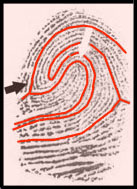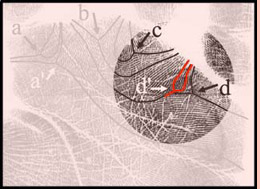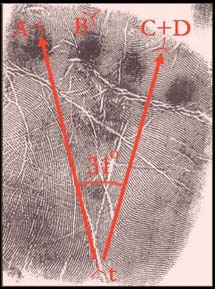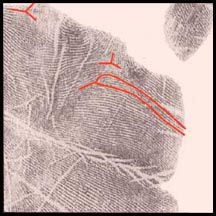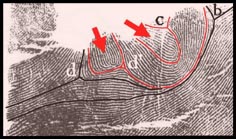Hand signs in Autistic Spectrum Disorder, a.k.a. 'Autism'


10 Years Hand Analysis Research
SPECIALISATION 1: HAND SIGNS IN AUTISM
Autistic spectrum disorder (ASD) can be described as a complex behaviour disorder including a wide variety of symptoms, which usually manifest before the child reaches the age of three: (1)
• Autistic children are not able to recognize and interpret the emotions of other people.
• The language capabilities are usually limited.
• Usually these people experience difficulties on starting a conversation, or to continue a conversation.
• Often they have a preoccupation with a single subject, activity or a certain gesture.
In scientific literature several studies have been presented focussed on the possible relationship between autism and biometric hand features. The continuation of the present page presents a short description about how the knowledge about autism evolved during the 20-th century. And in the second part I present some research results which indicate that autism is frequently accompagnied by rare dermatoglypics on the little finger.

an unappreciated piece in the AUTISM-puzzle?

After about a half century of research the phenomenon 'autism' is still considered as an unsolved puzzle. After the disorder was discovered in 1943 by Dr. Leo Kanner, scientists have made many attempts on describing the symptoms.
Asperger syndrome:
PDD-NOS:
Desintegrative disorder:
Rett syndrome:
38.4 in 10.000
12.0 in 10.000
0.5 in 10.000
0.5 in 10.000
For the time being the results are described in the DSM-IV
and ICD-10 (3). Within these classification
systems autism is recognized as belonging to the so-called
'Pervasive Development Disorders' (PDD).
For quite a while the causes of the
autistic disorder were dramatically misunderstood. In the sixties and
seventies most psychiatrists inclined to attribute the disorder to
"... de kille houding van de ouders ..." [a cold attitude of the
parents] (4).
Meanwhile scientists have discovered that hereditary factors - e.g. the genes - play an important part in the development of the disorder. Though the autistic disorder is usually present in at least 16 out of 10.000 babies (= 0.16 %), brothers and sisters have a 3 to 8 percent chance for getting diagnosed with the same handicap (1).
Another observation is that autism is frequently accompanied by a deviation in the brains: larger volumes are reported in several studies (5), and some aspects of the brainstem (1), the cerebellum and the limbic brains appear to be retarded in development (6). The large brainvolume is frequently accompanied by a large diameter of the skull (OFC) (7,8,9).
Apart from a large diameter of the skull other physical features were reported to be related to autism, e.g.: small feet combined with normal hands (10), and ear abnormalities('posterior rotation' (10), low seating of the ears (1,11) ).
Various researchers have also conducted research focussed on studying the relation between hand features and autism. Recently John T. Manning has established in his work 'Digit Ratio' that autism is frequently accompagnied by a so-called 'low 2D:4D ratio' - which indicates: a relative short index finger compared with the length of the ring finger (12).
In the past several studies have been conducted focussed on a possible relationship between autism and the dermatoglyphics on the fingertips (13-19). Various results appear to be inconsistent. In a research conducted by Wolman et.al. (17) - this program includes the largest studied group of autistics - individual dermatoglyphics features were reported to be insignificant. Nevertheless various studies have indicated that in the hands of many autistics the dermatoglyphics show rare characteristics. Walker (13) writes:
"... the finding of low atd angles on palms of autistic children, but many of the index children provided angles which were well below the lower limit of 55o reported by Holt. Of those children with atd angles below 55o (only two control children scored so low) it may be said that their palmar configurations were unusually constricted."
By the way, in only three studies (13,15,16) palmar dermatoglyphics were analyzed as well. On the basis of the research results which I have found in my own studies, I am inclined to say that in most of the published studies the attention of the researchers was one-sided focussed on the dermatoglyphics on the fingertips. On top that: the intelligence of the autists is usually hardly defined, and in most studies the autistic males and females were not studied seperately.
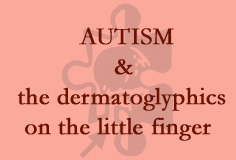
Autism is usually accompagnied with communication problems
which manifest in the relationships with the parents and in the contacts
with contemporaries as well. In traditional handanalysis communication
problems (with the parents) are frequently related to the little finger,
the so-called 'Mercury finger'. Edward D. Campbell writes
in 'The Encyclopedia of Palmistry':
"... The little finger deals with close personal relations, including parental relationships, intimate love, and sex. To these areas add possible gifts with music, speech, language, and other communications, and traditionally, as Mercury was the god of thieves, business." |
The STATISTICS of the research results - which are presented below - indicate that in the hands of 6 out of 19 male autistics with a normal intelligence (= 31.5%), the following combination of hand features is observed:
• FEATURE 1: rare features in the dermatoglyphics on the little finger
• FEATURE 2: 28 triradii are found in both hands + the proximal transversal line (the so-called 'head line') starts in both hands attached to the longitudinal line (the so-called 'life line').
For this combination was not found at all in the hands of the control group (= 0.0%) - which includes 200 normal males - the presence of this combination of hand features appears to be a strong indication for behavior problems related to autistic spectrum disorder.
By the way, this is not an 'arbitrary' combination of hand features. For, just like the above mentioned 'low digit ratio' - according John T. Manning is this hand feature frequently observed in the hands of autistics - FEATURE 1 and FEATURE 2 are known to be observed much more frequently in the hands of apes compared to the hands of human beings. As well in the hands of autistics!
Combined with the observations presented in the section Male-female differences, one can even use these observations for an explanation of the fact that autism is much more frequently observed in males compared to females!
Appendix:
| ||||||||||||||||||||||||||||||||||||||||||||||||||||||||||||||||||||||||||||||||||||||||||||||||||||||||||||||||||||||||||||||
REFERENCES:
1. "The early origines of autism" (2000)
2. Source: Centre for Human Development and Disabilities (CHDD)-Maastricht
3. "Het klassieke autisme of het syndroom van Kanner"
4. "Sprookjes over autisme" (www.trimbos.nl)
5. "Images Show Brain Growth In Autistic Kids" (2002)
6. "Brainstem, cerebellar and limbic neuroanatomical abnormalities in autism" (1997)
7. OFC (= Occipito Frontal Circumference): the diameter of the newborn skull measured around the forehead and the lowest point of the back of the head.
8. "Head circumference is an independent clinical finding associated with autism" (2000)
9. "Head circumference in autism, Asperger syndrome, and ADHD: a comparative study" (2002)
10. "Minor Malformations and Physical Measurements in Autism" (1997)
11. "Incidence of minor physical anomaly in autism" (1977)
12. "The 2nd to 4th digit ratio and autism" (2001)
13. "A dermatoglyphic study of autistic patients" (1977)
14. "Fingerprints and laterality preferences of early-onset autism" (1979)
15. "A comparative dermatoglyphic study of autistic, retarded, and normal children" (1979)
16. "Dermatoglyphic analysis of autistic basque children" (1990)
17. "Dermatoglyphic study in autistic children and controls" (1990)
18. "Dermatoglyphic analysis of autistic Basque children" (1991)
19. "Ridge hypoplasia and ridge dissociation: minor physical anomalies in autistic children" (1993)
